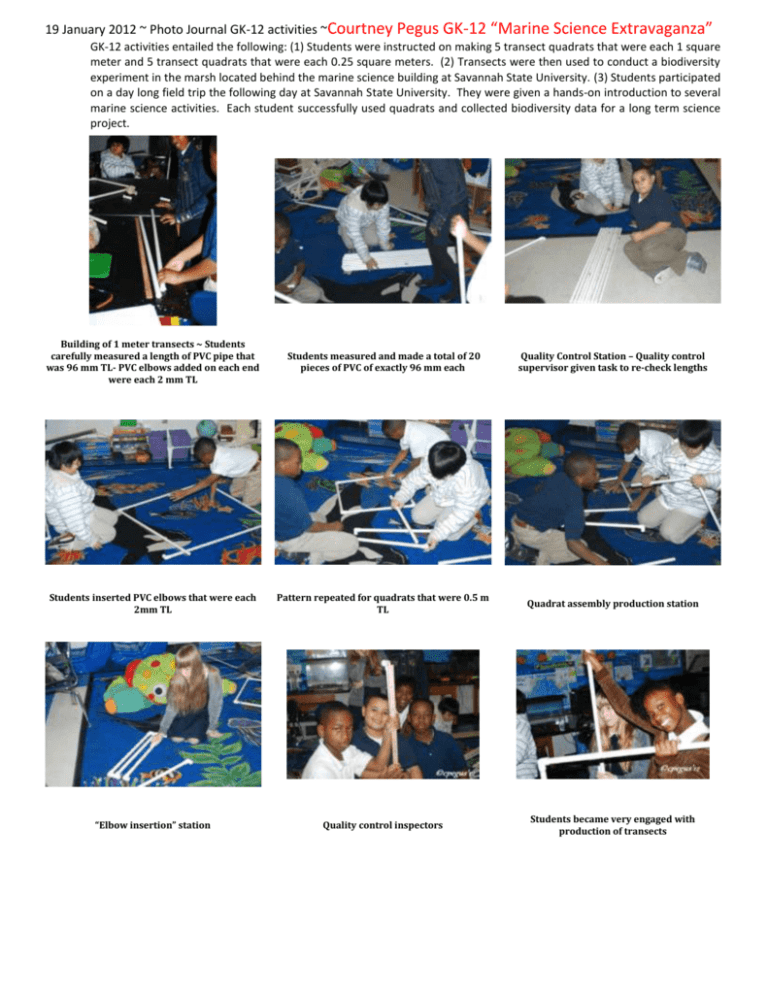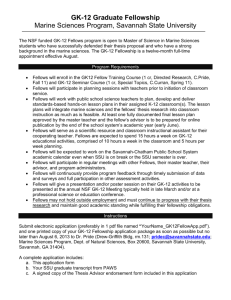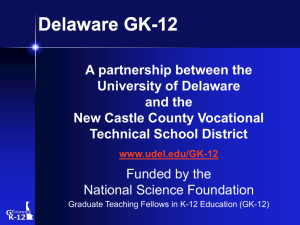19 January 2012 ~ Photo Journal GK-12 activities ~Courtney Pegus
advertisement

19 January 2012 ~ Photo Journal GK-12 activities ~Courtney Pegus GK-12 “Marine Science Extravaganza” GK-12 activities entailed the following: (1) Students were instructed on making 5 transect quadrats that were each 1 square meter and 5 transect quadrats that were each 0.25 square meters. (2) Transects were then used to conduct a biodiversity experiment in the marsh located behind the marine science building at Savannah State University. (3) Students participated on a day long field trip the following day at Savannah State University. They were given a hands-on introduction to several marine science activities. Each student successfully used quadrats and collected biodiversity data for a long term science project. Building of 1 meter transects ~ Students carefully measured a length of PVC pipe that was 96 mm TL- PVC elbows added on each end were each 2 mm TL Students measured and made a total of 20 pieces of PVC of exactly 96 mm each Quality Control Station – Quality control supervisor given task to re-check lengths Students inserted PVC elbows that were each 2mm TL Pattern repeated for quadrats that were 0.5 m TL Quadrat assembly production station “Elbow insertion” station Quality control inspectors Students became very engaged with production of transects 19 January 2012 ~ Photo Journal GK-12 activities ~Courtney Pegus GK-12 “Marine Science Extravaganza” Hands on methodology is emphasized in the Georgia standards Quality control inspectors recorded lengths of each quadrat assembled Students allowed to “show off” their work for quality control staff ~0.25 quadrats 1 square meter quadrats inspected. Special thanks to Dr. Carol Pride for purchasing materials and supplies Notes taken by quality control inspector Part II ~ Field trip to Savannah State University Mr. Hunter interacting with students getting students to discuss the ecology of estuaries Field trip was a walking event Savannah State University is in close proximity to many schools making field trips and other marine science events extremely inexpensive 19 January 2012 ~ Photo Journal GK-12 activities ~Courtney Pegus GK-12 “Marine Science Extravaganza” Students were eager to start using quadrats The enthusiasm to participate in marine science activities is apparent Walking field trip- Students walked along back roads to avoid high traffic areas Students were given specific tasks in collecting biodiversity data Biodiversity data collection entailed making careful measurements of TL of vegetation, soil temperature and total number of plants in quadrat Students arrive on Savannah State University campus Campus police officer gave a brief discussion on discipline and proper conduct Mr. Hunter (outreach coordinator @ SSU) gave an excellent introduction of the importance of estuaries, the ecology and ways in which different components of estuaries (soil, vegetation and organisms are inter-related Students were kept engaged by posing several questions to students and discussing responses 19 January 2012 ~ Photo Journal GK-12 activities ~Courtney Pegus GK-12 “Marine Science Extravaganza” After students were shown charts and maps of estuaries in Georgia they immediately made a connection with the field site Students were separated into groups of 4 Each group was given 1 transect and led out into the estuary A question was posed to students related to crab population and proximity to the water Students heading into the estuary located behind Savannah State University Ms. LaGina Frazier, was an excellent facilitator and instructor for the entire event Students were presented with the importance of estuaries as a barrier for tidal influences, important habitat for many commercially important food species (shrimp, crabs) Mr. Hunter led the discussions of the importance of estuaries from an ecological perspective as well as an economic perspective Parents of students were invited to participate in field activities and help with supervision of students 19 January 2012 ~ Photo Journal GK-12 activities ~Courtney Pegus GK-12 “Marine Science Extravaganza” Students were given different regions to investigate based on vegetation type One student was responsible for recording data, one for counting crab holes and the other for counting vegetation Students completed quadrat investigation and given another plot to record Quadrats were placed in regions that were visually different to impress upon students the concept of biodiversity Students spent approximately 2 h recording biodiversity data A benthic trawl was attempted using a kayak by one the parents (Tevah Will) Water dock side station Students were presented with a YSI logging instrument and made measurements of water salinity and temperature at different depths Mr. Hunter continued to keep the students engaged by discussing the relationship between water quality and the health of marine organisms 19 January 2012 ~ Photo Journal GK-12 activities ~Courtney Pegus GK-12 “Marine Science Extravaganza” Mr. Eric Parks who is very knowledgeable with recording biodiversity in transects assisted in giving students a meaningful experience with recording data Students were led on an “exploration journey” through the estuary to discover the various characteristics of soil texture, vegetation type and marine organisms The “exploration journey” gave students the opportunity to investigate oyster beds located at the edge of the estuary Students got a close up view of an oyster reef and a discussion was conducted on the unique adaptations of intertidal organisms A second benthic trawl was attemptedorganisms were collected and kept for students to investigate Students were given nets and allowed to catch grass shrimp and other small benthic organisms living around the floating dock Water chemistry station Students were lectured on the importance of water chemistry for the survival of marine life. The effects of Carbon Dioxide, greenhouse gasses, ocean acidification and acid rain on corals and marine life were discussed Students observed first-hand the relationship between coral health and water chemistry. Coral bleaching and reef destruction were key topics discussed (thanks to Dr. Hintz for use of facility) 19 January 2012 ~ Photo Journal GK-12 activities ~Courtney Pegus GK-12 “Marine Science Extravaganza” Students were given a tour of the filtration system at the Savannah State University marine wet lab that is used to purify the water in the research aquariums Students had the opportunity to make detailed observations of several species of marine organisms that were collected from the estuary behind campus Emphasis was placed on the relationship between commercially important species and estuaries Students were given a 30 minute lunch break where key points discussed earlier in the activities were re-visited The convenience and practicality of using the facilities at Savannah State University as a hub for teaching Natural Science to the surrounding educational institutions cannot be over emphasized Large groups can be easily accommodated and instructed by resident staff. Savannah State University has an active outreach program supported by Title VII and GK-12 funding Students had a remarkable time in the morning session and enjoyed the learning experience All groups visited every station on the list of planned events Dr. Hoskins (resident professor @ SSU) lectured for the afternoon session and discussed the importance of benthic environments 19 January 2012 ~ Photo Journal GK-12 activities ~Courtney Pegus GK-12 “Marine Science Extravaganza” Students were given a hands-on experience of the texture and other characteristics in benthic substrate Dr. Hoskins sieving a benthic mud sample using a 500 μm sieve off the floating dock. A polychaete worm found in the substrate was taken back to students for “show and tell” lecture Dr. Hoskins ended lecture by introducing the negative impacts of pollutants in estuaries on marine organisms ~ stating that polychaetes are important food items for commercially important shrimp and crab species but are susceptible to pollutants in the water and soil Dr. Ebanks (resident professor @SSU) continued the theme with a very engaging discussion on organics and pollutants in estuaries Dr. Ebanks emphasized that the ecology of the marsh system is disrupted by pollutants. Students discussed food chains and the possibility that commercially important species may become scarce if organics settle in the respiratory system of benthic organisms such as polychaete worms In the final part of the marine science experience, students made visual observations of the height change in the water and concluded that the flood tides and the gravitational effect of moon and sun on the ocean caused the height increase Closing remarks Hands on experience- students waved their muddy hands to show their approval of the field trip End of Lecture and the marine science extravaganza 19 January 2012 ~ Photo Journal GK-12 activities ~Courtney Pegus GK-12 “Marine Science Extravaganza” The marine science experience would not be possible had it not been for the help of the following people: Teachers ( Cameron Schmitz, Keri Carrasquillo and Jill I. Lepo-Wieniewitz) parents ( Erica Swopes, Tevah Will and J’maun Cutter) and the SSU staff Special thanks to Dr. Dionne Hoskins (SSU Professor and my graduate advisor) Special thanks to Dr. Sue Ebanks (SSU Professor and graduate of SSU) Special thanks to Mr. Greg Hunter (Outreach coordinator at SSU) Special thanks to Mrs. LaGina Frazier, Graduate student at SSU Special thanks to Mr. Eric Parks (Student at SSU) Special thanks to participating parents (Erica Swopes, Tevah Will and J’maun Cutter) and Dr. Carla Curran for use of trawl nets Special thanks to Savannah State University campus police Special thanks to Dr. Carol Pride and GK-12 grant money for supplying funding for this event.








